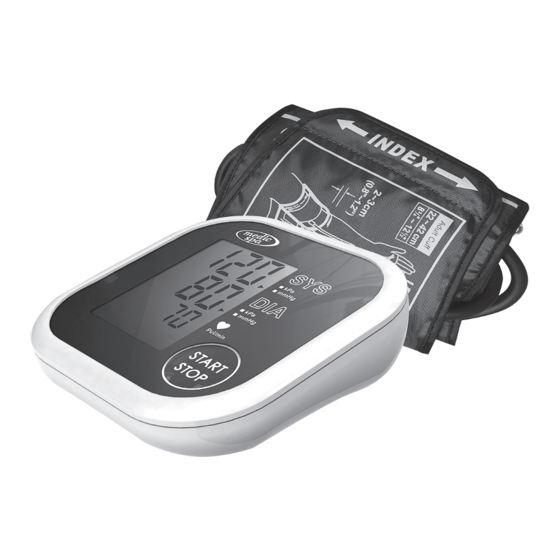
Summary of Contents for medic spa MATRIX 100
- Page 1 User Manual Blood Pressure Monitor Arm Type MATRIX 100 M. Feingersh & Co.Ltd 29 Habanay St., Holon. Tel: 03-5581666...
-
Page 2: Before You Start
INTRODUCTION General Description Safety Information LCD Display Signal Monitor Components Measure Principle BEFORE YOU START Installing and Replacing the Batteries Tie the Cuff MEASUREMENT Start the Measurement INFORMATION FOR USER Tips for measurement Maintenances ABOUT BLOOD PRESSURE What are systolic pressure and diastolic pressure? What is the standard blood pressure classification? Why my blood pressure is varies even in one day? Why the blood pressure I get from the hospital is different from home? -
Page 3: General Description
GENERAL DESCRIPTION Thank you for selecting TRANSTEK arm type blood pressure Monitor (TMB-1491-A). The monitor features blood pressure measurement and pulse rate measurement. The design provides you with two years of reliable service. Reading taken by the TMB-1491-A are equivalent to those obtained by a trained observer using the cuff and stethoscope auscultation method. -
Page 4: Lcd Display Signal
To avoid measurement errors,Please avoid the condition of strong electromagnetic field radiated interference signal or electrical fast transient/burst signal when using the AC adaptor. The user must check that the equipment functions safely and see that it is in proper working condition before being used. -
Page 5: Monitor Components
MONITOR COMPONENTS LIST... -
Page 6: Measurement Principle
MEASUREMENT PRINCIPLE This product uses the Oscillometric Measuring method to detect blood pressure. Before every measurement, the unit establishes a “zero pressure” equivalent to the air pressure. Then it starts inflating the arm cuff, meanwhile, the unit detects pressure oscillations generated by beat- to-beat pulsatile, which is used to determine the systolic and diastolic pressure, and also pulse rate. -
Page 7: Start The Measurement
2.The cuff should be sung but not too tight. You should be able to insert one finger between the cuff and your arm. 3.Sit comfortably with your tested arm resting on a flat surface. 4.Patients with Hypertension: The middle of the cuff should be at the level of the right atrium of the heart;... -
Page 8: Tips For Measurement
2.Press the “START/STOP” to power off, otherwise it will turn off within 1 minute. TIPS FOR MEASUREMENT It can cause inaccuracy if the measurement is taken in the following circumstances. -
Page 9: Maintenance
MAINTENANCE In order to get the best performance, please follow the below instructions. • If you have any problems with this device, such as setting up, maintaining or using, please contact with SERVICE PERSONNEL of M.FEINGERSH & CO LTD. Don’t open or repair the device by yourself. •... -
Page 10: What Is The Standard Blood Pressure Classification
WHAT IS THE STANDARD BLOOD PRESSURE CLASSIFICATION? The blood pressure classification published by World Health Organization (WHO) and International Society of Hypertension (ISH) in 1999 is as follows: WHY DOES MY BLOOD PRESSURE FLUCTUATE THROUGHOUT THE DAY? 1. Individual blood pressure varies every in one day, it also affected by the way you tie your cuff and the your measurement position, so please take... - Page 11 IF THE RESULT IS THE SAME IF MEASURING ON THE RIGHT ARM? It is ok for both arms, but there will be some different results for different person, so suggest you measure the same arm every time. This section includes a list of error messages and frequently asked questions for problems you may encounter with your blood pressure monitor.
- Page 12 WARNING: No modification of this equipment is allowed.
-
Page 13: Complied European Standards List
COMPLIED EUROPEAN STANDARDS LIST Risk Management EN/ISO 14971:2012 Labeling EN 1:2012-15223 User Manual EN 1041:2008 Generl Requirements for Safety EN 1:2006-60601/AC2010 EN 11:2010-1-60601 Non-invasive EN +1:1995-1060A2:2009 Sphygmomanometers EN +3:1997-1060A2:2009 General Requirements EN 4:2004-1060 Electromagnetic Compatibility EN 2:2007-1-60601 Software Lifetime EN 62304:2006/AC:2008 Usability EN 6:2010-1-60601 EN 62366:2008...


Need help?
Do you have a question about the MATRIX 100 and is the answer not in the manual?
Questions and answers